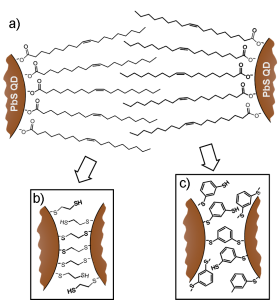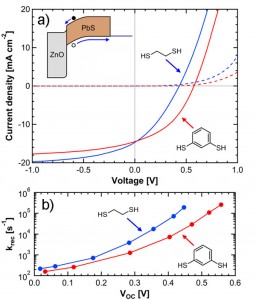Ligand Exchange for Performance Optimization of Lead Sulfide Quantum Dot Photovoltaics
- Category: Energy, Nanotechnology
- Tags: patrick brown, quantum dot photovoltaics, vladimir bulovic
Solar cells based on lead sulfide quantum dots (PbS QDs) represent a promising new class of solution-processable photovoltaics. The highly tunable bandgap of PbS QDs (0.5-2.1 eV) makes them ideally suited for incorporation into multijunction architectures, and their resistance to oxidation and photobleaching represent further advantages over typical solution-processed photovoltaic materials such as organic small molecules and polymers [1] [2] .
The electronic properties of QD films are determined not only by the size and composition of the QDs themselves but also by the properties of the organic ligands used to passivate the QD surfaces. As-synthesized PbS QDs are stabilized in solution by long, insulating oleic acid ligands, which are unsuitable for use in photovoltaics, where efficient electron transport is required. Therefore, a ligand-exchange treatment is typically performed, replacing the oleic acid ligands with short, bidentate molecules such as 1,2-ethanedithiol (EDT). Our research demonstrates that the power conversion efficiency of ZnO/PbS QD heterojunction photovoltaics [3] may be enhanced through ligand exchange with 1,3-benzenedithiol (BDT) rather than the more common EDT, despite the fact that BDT-treated films demonstrate a lower charge carrier mobility than EDT-treated films. Treatment with BDT simultaneously increases the fill factor (FF) and open-circuit voltage (VOC) relative to treatment with EDT, thereby increasing the power conversion efficiency by a factor of 1.6, from 2.1% to 3.4%. Measurement of the transient photovoltage response of the devices indicates that this increase in FF and VOC results from a decrease in the rate of bimolecular recombination and the concomitant increase in carrier lifetime within the QD film. This increase in carrier lifetime more than compensates for the lower mobility of BDT-treated films, emphasizing the importance of designing ligands that simultaneously decrease the inter-QD spacing and effectively passivate surface recombination sites.
- Figure 1: Schematic representation of lead sulfide quantum dots with a) oleic acid ligands. Following ligand exchange, the oleic acid ligands are replaced with b) 1,2-ethanedithiol (EDT) or c) 1,3-benzenedithiol (BDT).
- Figure 2: a) Current-voltage characteristics of a ZnO/PbS QD heterojunction photovoltaic device, where ligand exchange has been performed with EDT (blue trace) or BDT (red trace). BDT treatment simultaneously increases the fill factor, open-circuit voltage, and efficiency. b) Transient photovoltage response of the device, demonstrating a reduced recombination rate (krec) for BDT-treated devices relative to EDT-treated devices.
- J. Gao, J. M. Luther, O. E. Semonin, R. J. Ellingson, A. J. Nozik, and M. C. Beard, “Quantum dot size dependent J-V characteristics in heterojunction ZnO/PbS quantum dot solar cells,” Nano Letters, vol. 11, pp. 1002-1008, Feb. 2011. [↩]
- X. Wang, G. I. Koleilat, J. Tang, H. Liu, I. J. Kramer, R. Debnath, L. Brzozowski, D. A. R. Barkhouse, L. Levina, S. Hoogland, and E. H. Sargent, “Tandem colloidal quantum dot solar cells employing a graded recombination layer,” Nature Photonics, vol. 5, pp. 480-484, Aug. 2011. [↩]
- P. R. Brown, R. R. Lunt, N. Zhao, T. P. Osedach, D. D. Wanger, L.-Y. Chang, M. G. Bawendi, and V. Bulovic, “Improved current extraction from ZnO/PbS quantum dot heterojunction photovoltaics using a MoO3 interfacial layer,” Nano Letters, vol. 11, pp. 2955-2961, June 2011. [↩]

